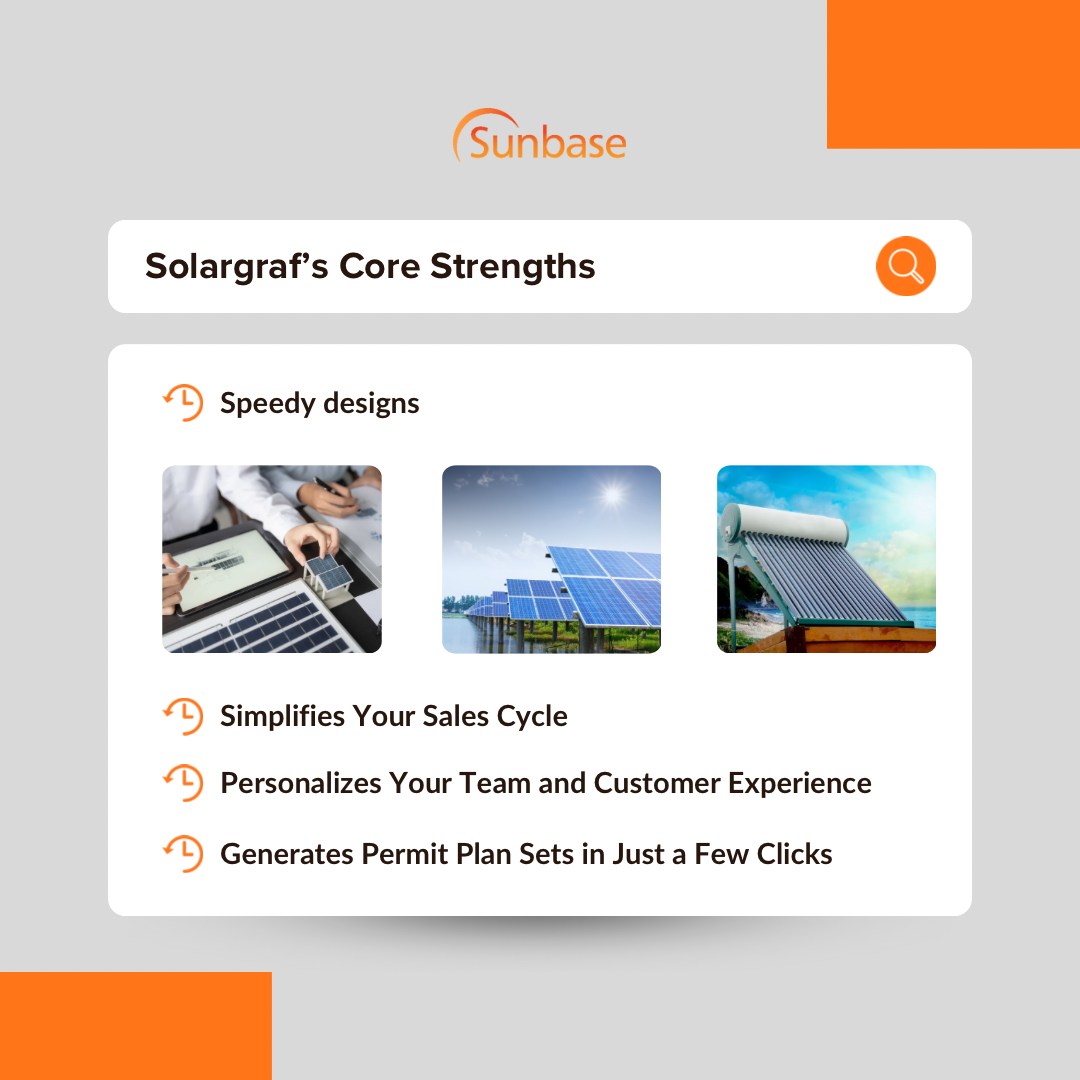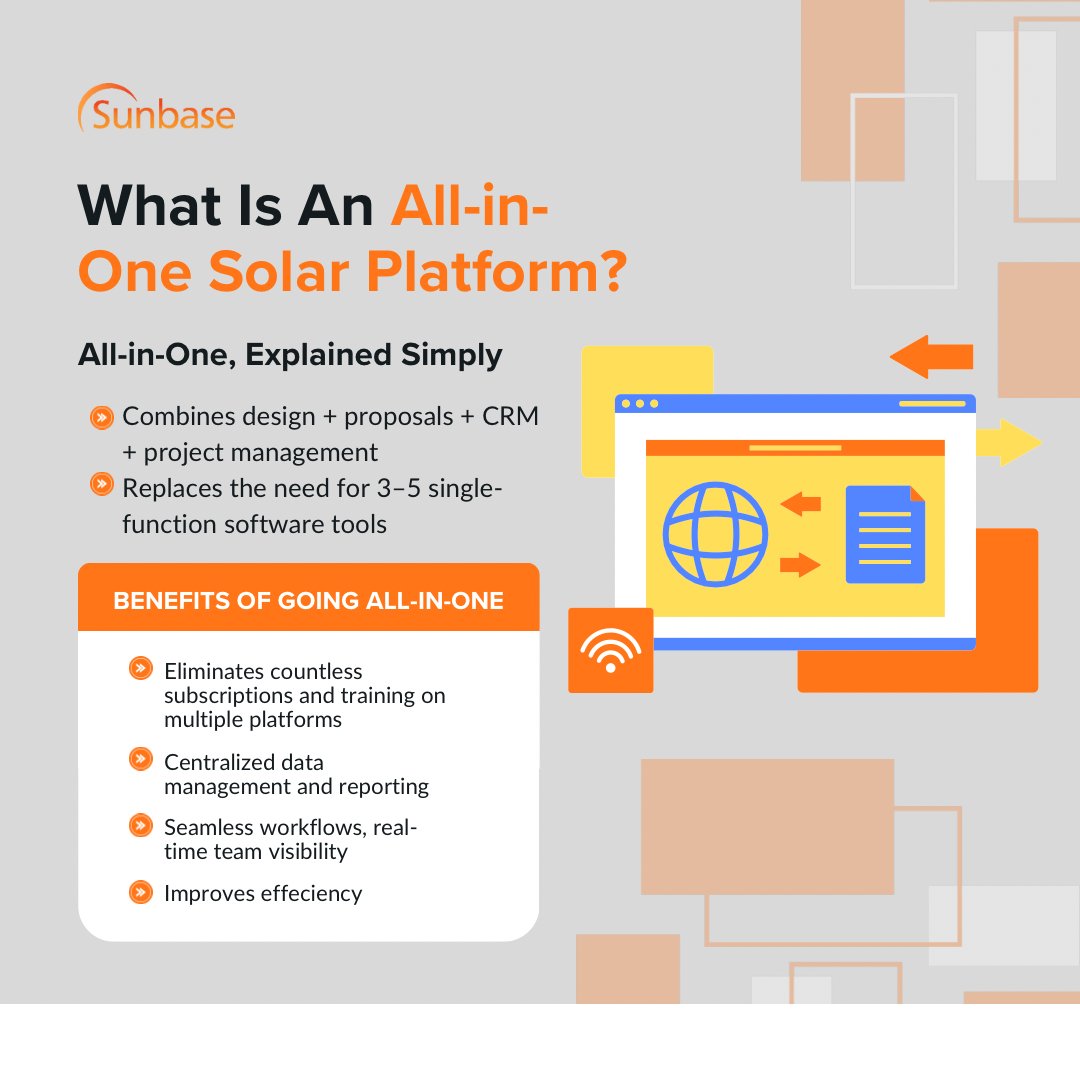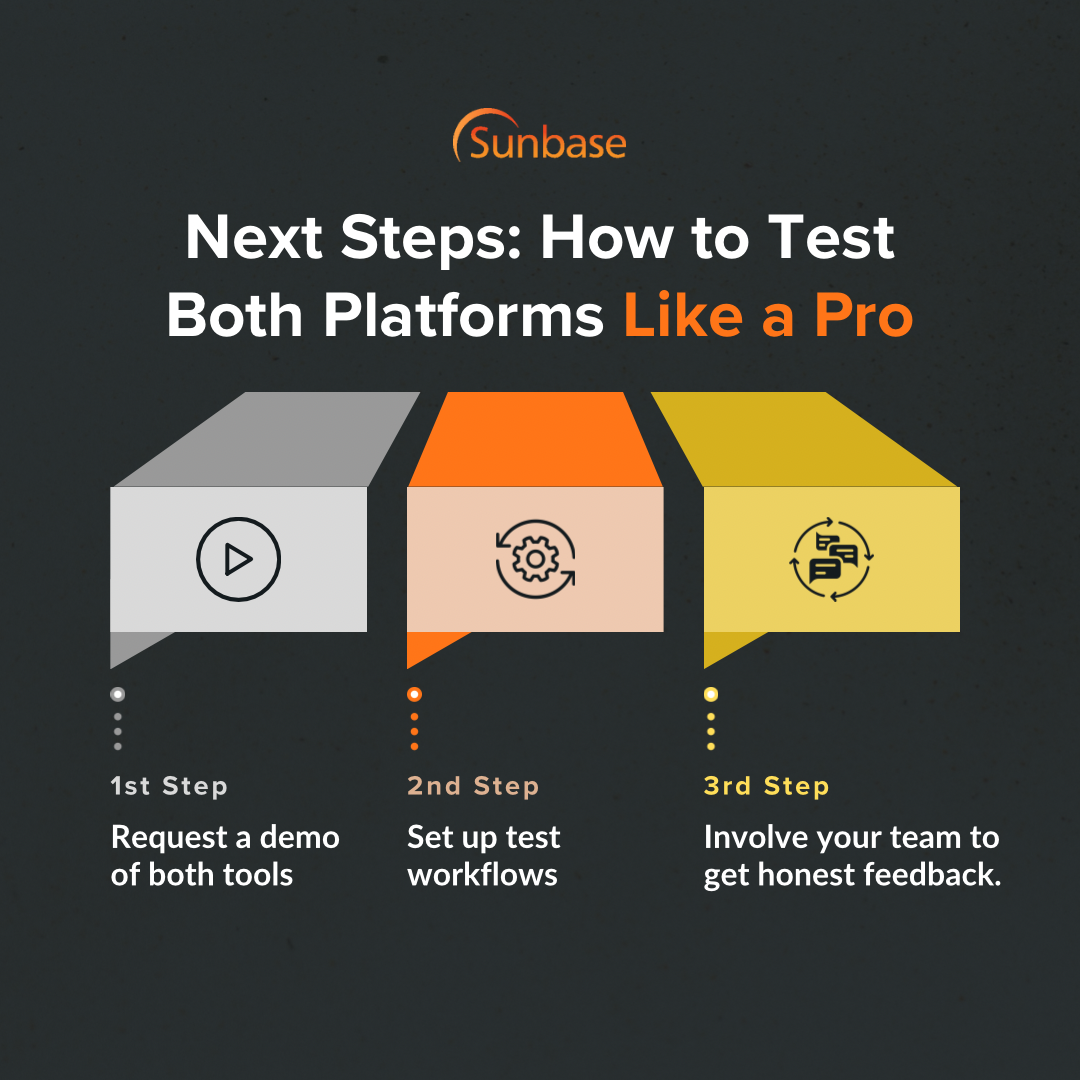August 22, 2025
Audio overview: Listen & Learn
Stuck between going all-in-one or a specialized design and proposal tool?
Every solar business reaches this crossroads shortly after wondering why the design and proposal stage proceeds smoothly, while everything else feels lagging.
Solargraf is one such specialized tool that excels at what it does, creating sleek and accurate proposals at speed.
But when your team starts managing leads, scheduling, and customer follow-ups, you may begin to crave an all-in-one system that handles everything.
It’s kind of like choosing between too many good options, but only one combo that hits just right. So, how do you decide?
Solargraf vs All-in-One Solar Software: Key Differences in 2025
The tools you choose can either accelerate or hinder your workflow. This blog breaks down the main differences between Solargraf, a specialized solar design and proposal tool, and all-in-one platforms that integrate CRM, project management, proposal, canvassing, and design into one system.
Whether you’re a solo installer or expanding your solar business, find out which approach fits your needs, reduces costs, and improves team efficiency.
So should you stick with Solargraf’s laser-sharp speed or go big with a platform that does it all? Let's break it down for you: features, pricing, workflows, and who each option is best suited for.
Key Takeaways
- The solar industry faces challenges such as tricky solar system design, supply chain issues, price volatility, legislative uncertainty, and skill shortages. That's where solar software can help.
- Solargraf offers speedy designs, proposal generation, and design accuracy, but lacks built-in CRM, detailed sales management, and operations tools, requiring integrations.
- Instead of juggling different tools, using all-in-one solar software like Sunbase and OpenSolar helps you consolidate everything into one seamless system.
- To evaluate platforms professionally, request a demo, set test workflows, and engage your team for honest feedback.
Exploring the Landscape of Solar Software in 2025

Challenges faced by the solar industry today:
1. Tricky Design of Solar Energy System
Designing a solar energy system isn’t just dragging and dropping solar panels on a digital roof. Solar design demands calculating everything from panel angles to shade patterns. One miscalculation, and the rooftop becomes just another costly project.
2. Supply Chain Issues and Price Volatility
Yes, solar prices have fallen significantly over the past decade, but the last few years tell a different story. COVID-19 disrupted supply chains, inflation surged, and global trade tensions brought tariffs and market volatility.
A positive development is that the increased availability of American-made modules and a more stable supply chain are beginning to find balance. However, the industry still struggles to handle surprises.
3. Political and Legislative Uncertainty
Due to proposed revisions to clean energy tax credits, the US solar industry encounters more uncertainties and fluctuations than any other sector. Over $8 billion in clean energy projects have already been cancelled in 2025 alone due to policy shifts.
4. Skill Shortages and Workforce Development
Sunlight is free, but skilled labor comes at a cost.
According to the Department of Energy, the solar industry needs to expand from its current 330,000 workers to 1.5 million by 2035 for the U.S. to meet its decarbonization targets. That’s a big challenge, especially as younger workers increasingly favor tech and remote jobs over traditional rooftop work.
What is your approach to solving them?
How Does Solar Software Help And Matter Now More Than Ever?
First things first! What's solar software?
Solar software is the key tool for solar professionals seeking to create standout designs and proposals, minimize operational costs, manage projects, and stay compliant with evolving industry regulations.
Adding solar software to your company’s tech stack allows you to create precise layouts, streamline sales processes, and improve customer presentations. So, why do you need it more than ever right now?
Because:
- Your potential customers have endless options and expect polished proposals in minutes, not days.
- One design miscalculation can cost you thousands in lost materials, labor, and rework.
- Missing one deadline can stall permits, push back other installs, and stress your entire team.
- One negative review on Google can turn away ten potential leads.
- Juggling spreadsheets, site visits, and scattered tools no longer cuts it in a high-speed, high-stakes market.
From design automation to supply chain management, from AI-powered optimization to workforce development, software is transforming every aspect of utilizing the sun's energy.
For solar companies, adopting these tools is a matter of survival, and for consumers, it means faster installations, better designs, and lower costs. That’s why modern solar companies run on smarter software. Let's explore them. Starting with Solargraph...
What Is Solargraf? A Niche Tool with Singular Focus On Proposals & Design
Solargraf At A Glance
Solargraf is what you get when solar design meets slick efficiency. It's cloud-based solar software designed to help installers skip the headaches and focus on what matters: clean designs, quick proposals, and satisfied homeowners.
Whether you're working from the office or the field, Solargraf keeps everything in sync. Its easy-to-use interface means you don’t need to be a tech expert to get high-quality results.
One of its standout features? Remote shading tools that allow you to scan rooftops and simulate sun exposure. Combine that with fast proposal creation that’s both neat and customizable, and you have a tool that speaks both sales and solar.
Coming to the fact, who is it ideal for? Both residential and commercial projects.
Time to find out more!
What Are The Core Strengths Of Solargraf?

> Speedy Designs
Yes, speed matters. However, in solar design, speed without accuracy is just guesswork with a well-planned layout.
1. Optimized For Real-World Production, Not Just Renderings
You’re not just installing panels on a roof; you’re engineering a high-performing energy system. Solargraph has a
LIDAR-powered tool that automatically detects roof pitch and height, while real-time shading analysis helps you optimize panel placement for maximum output.
2. Flexible Imagery, Your Way
Create designs from any angle using high-resolution images from Nearmap, Google Maps, or Bing Maps. For new builds, simply upload blueprints or drone photos to ensure a clear view and complete design control.
3. Smarter Designs Backed by Data
It uses solar irradiance data to identify shaded areas, optimize panel placement, and manage obstructions, while automating 3D roof modeling with advanced LIDAR technology.
> Simplifies Your Sales Cycle
Your main work starts here....
1. Create Personalized Proposals
Make your proposals stand out by adding your company’s logo, colors, and style. It includes product images or videos to help customers visualize their system and turn your sales conversation into a smooth, confident pitch.
2. Give Customers Financing Options That Work
Solargraf simplifies presenting flexible financing options and displays multiple loan options side by side in one proposal.
With integrations for Mosaic, Dividend, and Goodleap, you can offer direct financing instantly. Additionally, you can provide lease or PPA options.
3. Close Deals Faster with E-Signatures
Avoid spending unnecessary time on paperwork. Send contracts for instant approval with Solargraf’s seamless DocuSign integration, and get that signature while interest is still high.
4. Customize Storage Systems with Confidence
Match each customer's energy goals with the right-sized battery setup. Solargraf supports storage solutions from 10 leading manufacturers, giving you a wide range of options without the complexity.
> Personalize Your Team and Customer Experience
Solargraf isn’t just about what the customer sees; it’s also about making life easier for your team.
1. Easy Team Access & Control
Ensure the right people have access to the appropriate tools, no more, no less. Whether it’s project managers, sales staff, or accounting personnel, you can assign role-specific permissions to maintain organization and security.
2. Proposals That Put Customers First
Customize proposals to suit clients by offering multiple products and prices in one professional presentation. You can create unlimited projects and show up to three design options each, making it easy for customers to pick the best fit.
> Generate Permit Plan Sets in Just a Few Clicks
Yes, permits are usually a hassle, but not in this case.
1. From Proposal to Permit: Everything Simplified
Why start from scratch? Using Solargraf, you can effortlessly transform your approved proposals into permit-ready plan sets with a few taps. Maintain control of the process while automation handles the work, saving time without compromising compliance.
2. Fast, Accurate, and Scalable Permits
Solargraf’s Permit Services provide accurate, code-compliant solar and storage plan sets swiftly. Built-in automation guarantees that each permit is consistent, top-quality, and ready to expand with your business.
So, what is Solargraph's pricing?
Curious about pricing, here:
- Starter: $2,799 USD annually
- Small Business: $4,799 USD annually
- Teams: $6,399 USD annually
- Enterprise: $12,999 USD annually
Now, let's discuss what it might not cover, because even the most powerful tools can have their blind spots.
What Solargraf Doesn’t Cover?
Solargraf focuses heavily on design and proposals, and it does them very well, but it doesn’t cover a built-in CRM, detailed sales tracking, or canvassing tools that manage your operations and field teams.
So if you need canvassing, lead nurturing, or end-to-end project management? You’ll need third-party integrations to fill in the gaps. That’s where a platform like Sunbase can help you: design, built-in CRM, lead tracking, team coordination, all in one place.
So, if you're looking to cut down on switching between apps and streamline your solar hustle, Sunbase offers the all-in-one flow that Solargraf doesn’t aim to cover.
Choose better today with the complete guide to deciding the best Solar CRM in 2025.
What Is An All-in-One Solar Platform?

One tool for design, another for proposals, a third for CRM, a fourth for project management, and before you know it, you're overwhelmed with tabs, passwords, and it becomes too much. That's exactly where an all-in-one solar platform can solve the problem.
All-in-One, Explained Simply
Simply put, an all-in-one platform brings your design, proposals, CRM, financing, scheduling, project tracking, and more into a single system.
Rather than switching between 3 to 5 different tools, you bring everything together into one seamless system.
This not only saves you time but also helps prevent mistakes and gives your team a reliable, central place to find the information they need.
Benefits of Going All-in-One
- Saves Time & Money: No more endless logins, overlapping subscriptions, or training your team on five different platforms.
- Centralized Data & Smarter Reporting: Avoid digging through scattered spreadsheets or apps to find data. Centralizing everything simplifies reporting and leads to more informed decisions.
- Improved Team Efficiency: Faster proposals, cleaner handoffs, fewer mistakes. When your team isn’t switching between systems, they spend more time closing deals and completing installations.
- Seamless Workflows & Real-Time Visibility: Your entire process, from lead to install, is integrated. Sales is aware of operations, and operations are informed when sales close.
- Built to Scale with Your Team: All-in-one platforms are designed specifically for expanding solar companies, especially those integrating sales and operations in one system.
Simply put, as your team expands, your system adapts with you.
In-depth Look At Sunbase and OpenSolar: One Tool That Does Everything
1. Sunbase
Sunbase is a leading all-in-one solution, specifically designed for the solar industry. With Sunbase, you can effortlessly keep track of each project stage, assign tasks to your team members, and make sure everything gets done on time, all from one convenient dashboard.
Best For:
- Ideal if you're looking for a single software to manage everything.
Key Features:
- Solar design tools for creating PV arrays, including remote site assessment using 3D modeling, LiDAR, satellite imagery, ground mount, accurate layouts, and exact energy production simulations.
- The built-in solar CRM assists in managing prospect data, monitoring customer interactions, automating follow-ups, and customizing communication.
- It offers proposal generation, simplifying the creation of professional, personalized, and branded proposals with useful features like e-signatures and financial tools.
- Project management features help track project progress, schedule meetings, assign tasks, and facilitate smooth real-time collaboration among team members.
- The door-to-door canvassing feature offers tools like route optimization, lead management, and performance tracking, allowing for effective outreach.
Integration Capabilities:
- Integrates with CRM software, accounting tools, design software, and even marketing platforms.
Pricing:
- Schedule your personalized demo here to learn more about pricing.
2. OpenSolar
OpenSolar is a cloud-based platform designed to help solar professionals manage every aspect of their business.
It is especially known for its free pricing, making it an appealing choice for startups and smaller companies in the solar industry.
Best For:
- Ideal for startups or lean teams seeking free tools with strong design and sales features.
Key Features:
- The design tool, approved by a US government agency and PVEL, utilizes photogrammetry-based DSM technology for precise shading estimates and features a performance calculation engine for enhanced user experience.
- Interactive proposal software includes integrated payment processing, various financing choices, e-signature functionality, and services to support multiple business models.
- It provides a built-in CRM for managing customers and businesses, or it can connect with existing CRMs through API, allowing smooth communication and scheduling.
- Facilitates efficient management of projects, tasks, and team members through customizable assignments and permission settings.
Integration Capabilities:
- Integrates with Bridge Select, SolarAPP+, Segen, and many more.
Pricing:
- OpenSolar offers free features and optional add-ons, like HD premium imagery bundles, to further improve your experience.
Understanding the Two Approaches: Focused vs Integrated
Suppose you're trying to impress a customer. You choose Solargraf? Great at what it does: quick, attractive, and to code. However, when it’s time to install, your solar project often misses deadlines, and there's no follow-up after installation.
That’s the difference between a focused tool and an all-in-one solar platform. There is no doubt that Solargraf helps you secure the job with its sharp focus on proposals and design, creating a strong first impression.
However, after signing the contract, managing multiple tasks becomes complicated if you’re switching between apps. When the project progresses beyond the pitch, you'll still need to integrate with other systems.
That’s where an all-in-one solution like Sunbase stands out. Because at the end of the day, selling solar isn’t just about efficient solar system design, it’s about managing the entire journey, start to finish.
Here's a comprehensive guide to help you distinguish between Solar Design Software and Solar Software.
Solargraf vs.Sunbase vs OpenSolar: Head-to-Head Comparison
| Features | Solargraph | Sunbase | OpenSolar |
|---|---|---|---|
| Proposal Tools | Excellent | Excellent | Excellent |
| Design Accuracy | High-resolution imagery | High-resolution imagery | Premium imagery |
| CRM Integration | External | Built-in | Built-in |
| Project Management | Not included | Included | Included |
| Lead Nurturing | Not included | Included | Not included |
| Pricing Simplicity | Straightforward | Varies by features | Free and Paid |
Who Should Use What? Real-World Business Scenarios
Whether you’re a one-person powerhouse or a growing solar team, here’s how to choose your tech stack:
> The Solo Installer or Small Crew
Go with: Solargraf
If you’re a solo installer or a small team focused on fast proposals and quick wins, Solargraf is an ideal fit.
- It focuses on what you need most: solar design, proposal creation, and financing solutions.
- Additionally, it works seamlessly with tools you already use, such as CRM, emails, contracts, and more.
Think of it as your design and proposal partner, created to impress without overwhelming you with unnecessary stuff.
> The Scaling Sales + Ops Team
Go with: Sunbase
You’re managing multiple tasks like closing deals, overseeing installs, and following up with customers, probably all at once. You need a system that keeps all these activities connected.
- Sunbase is a true all-in-one solar platform: CRM + Design + Proposals + Project Management + Reporting
- No bouncing between tabs or unmanageable integrations.
It’s like having a project manager, designer, sales ops lead, and data analyst, and that's all you need.
> The Outreach-Focused or Remote-First Team
Go with: OpenSolar
If you’re more focused on remote sales, need a free platform, or are expanding into different regions, OpenSolar is a solid choice.
- You’ll get powerful design features and flexible proposal tools
- It’s convenient for solar developers and companies working on utility-scale projects
OpenSolar offers flexibility without initial software expenses. It’s perfect if your team is dispersed or if you focus more on design and proposals than on complex integrations.
See how you can maximize ROI using All-in-One Solar Software.
Quick Checklist: Which Solar Software Is Right for You?
| Need | Choose Solargraf | Choose All-in-One Software (Like Sunbase) |
|---|---|---|
| Need fast proposals. | ✔ | ✔ |
| Already using a CRM. | ✔ | ✔ |
| Want design + CRM in one. | X | ✔ |
| Managing a large install team. | X | ✔ |
| Want a mobile app for reps. | ✔ | ✔ |
| Need advanced 3D tools only. | ✔ | ✔ |
| Want a single login experience. | X | ✔ |
Next Steps: How to Test Both Platforms Like a Pro

So, you’re stuck between sleek design and solar proposal software and a comprehensive, all-in-one platform.
Here’s how to cut through the hype and find the right solar design software for your team.
1. Request a demo of both tools
Begin by demoing tools. Most providers offer a free demo, which is the best way to try out features without paying licensing fees.
2. Set up test workflows
Outline a simple workflow covering lead generation, design, proposal, and installation. Whether you’re a solo solar installer or part of a team handling utility-scale projects, this practical trial will provide insights far beyond what a feature list can offer.
3. Involve your team to get honest feedback.
Encourage your team, including solar designers, operations leads, sales team members, and solar developers, to explore the interface, test its features, and simulate actual scenarios.
- Does the tool help them to work more quickly or slow them down?
- Does it reduce costs or make the entire sales process easier?
- Is it a specialized tool that performs well for one task, or does it support your entire business model?
The best choice isn’t solely based on its features. Instead, consider how well it integrates into your workflow.
Test like a professional and involve your team to determine what functions best.
In a nutshell
Ultimately, it’s not about selecting the flashiest solar software; it’s about choosing the one that fits your team, your goals, and your growth stage.
Solargraf is a sharp, streamlined choice if quick designs and polished proposals are your focus. But if you're ready to scale and unify your sales, design, and operations into a seamless system, an all-in-one platform like Sunbase could be your best move.
Focus on the long-term. The right tool not only assists in closing deals but also enables you to deliver, replicate success, and expand without confusion consistently.
Go All-in-one with Sunbase
Your current stack is working. Just not together. Fix that with Sunbase, the tool that replaces them all.
Experience a smarter way to sell solar.
One login. One platform. All the tools. Test drive Sunbase now!
FAQ’s
1. Which software tools are commonly used for designing solar PV systems?
Common software tools for designing solar PV systems include Sunbase, Solargraf, Aurora Solar, Helioscope, and PVsyst. These tools help solar designers accurately model energy output, assess shading, optimize panel placement, and prepare proposals. Each has its own strengths and limitations.
2. Can solar design tools like Solargraf handle detailed reporting and maximum efficiency calculations?
Solargraf excels at quick, visually appealing proposals. Still, for detailed reports or modeling that maximize efficiency, especially in complex cases, you might want to explore platforms like Sunbase or Aurora Solar, which offer more advanced analytics.
3. How does an all-in-one solar software improve proposal generation?
An integrated platform simplifies the entire proposal creation process, from initial design to detailed financial analysis. It eliminates the need to switch tools, providing energy output estimates and pricing information quickly with consistent branding and accuracy.
4. What makes all-in-one solar software better for project management?
Instead of stitching together multiple apps, an all-in-one solution integrates project management, team collaboration, and customer engagement in one platform. This enables your team to track every step while minimizing manual errors and saving time.
I agree to receive marketing messaging from Sunbase at the phone number provided above. I understand data rates will apply, and can reply STOP to OPT OUT.







